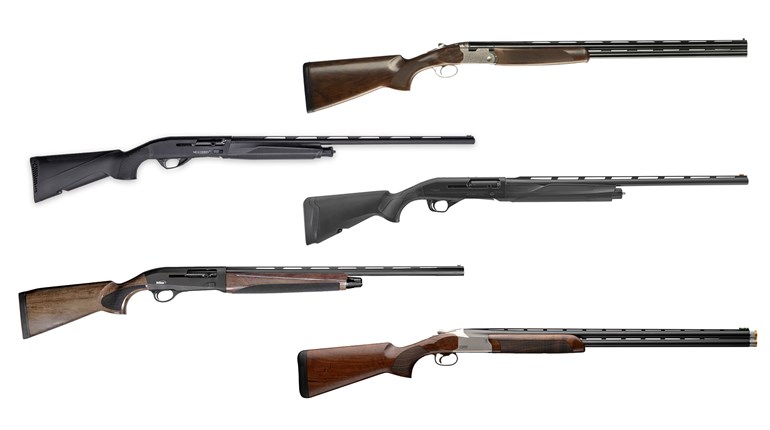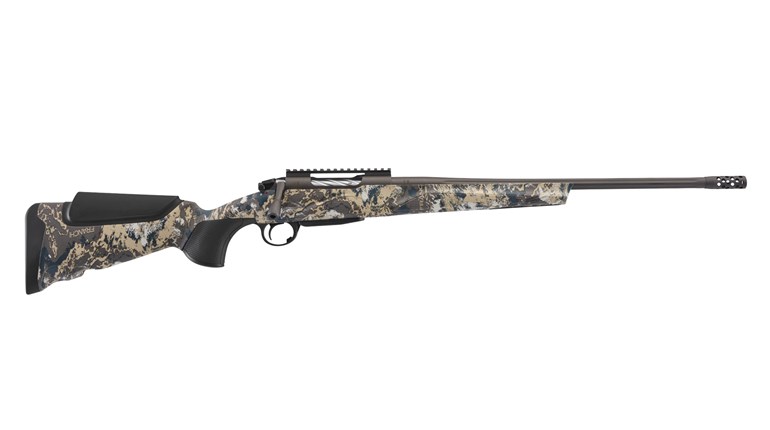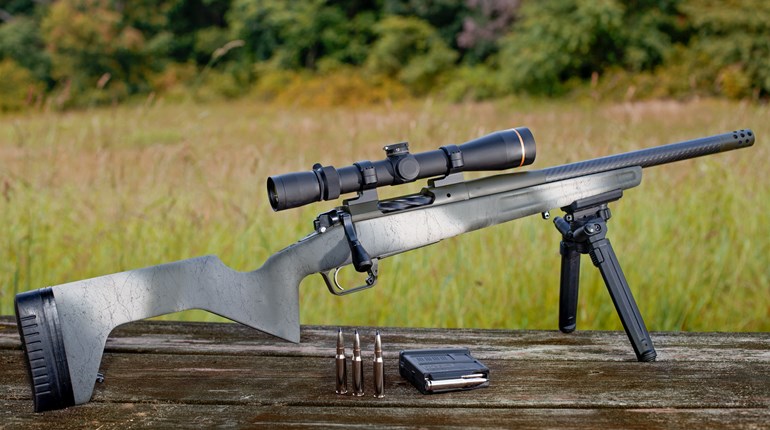
From 1958-2016, the Weatherby Mark V bolt-action rifle changed little. Its characteristic robust, nine-lug bolt, and its stock defined by a Monte Carlo, deep pistol grip and flattened fore-end remained recognizable in a U.S. commercial rifle market that saw no dearth of stylistic changes over 58 years. But a new century demanded a new look. Now in its second year of production, the New Mark V embodies the DNA that identifies it as Weatherby’s flagship but is tweaked to remain relevant today.
The backstory of how the action and stock were conceived explains why the New Mark V is called a refinement rather than a redesign.
From 1945, Roy Weatherby built and sold his Deluxe rifles on domestic and foreign actions. But he designed his own action in the 1950s to harness his powerful cartridges, and to stake his name to an iconic rifle. To build it, he sought partners domestically and in Europe, and settled in 1958 with J.P. Sauer & Sohn of Eckernfoerde, West Germany.
Roy was convinced his action protected shooters better from high-pressure cartridges that might cause blown primers and ruptured case heads, thus blowing gas back into a shooter’s face—a problem not unheard of an era of “wildcatting.” Most actions on the market at the time withstood 70,000 copper units of pressure (CUP), but Roy wanted an action that could handle 200,000 CUP.
His design, the same used today, countersinks the bolt face to surround the cartridge case head; the bolt fits into a counter-bored barrel breech; it is almost impossible for the case head to rupture. A shrouded bolt sleeve prevents gas blowback. Three vent holes in the head of the bolt relieve gas laterally in case of a blown primer. The bolt wears nine lugs in alternating rows of three—like artillery breechblocks Roy studied. They do not extend beyond the diameter of the bolt body, and the bolt body is the same diameter as the receiver, so when the bolt is worked it runs fluidly in the receiver.
Mathewson Tool Co. of Connecticut produced the first prototype, in 1955. Four iterations followed before Roy introduced the Mark V in 1958. Initial manufacture occurred at company headquarters in South Gate, Calif. About the same time, Roy contracted with Sauer, to meet demand, and production moved offshore. That arrangement lasted until 1973; then production shifted to Howa of Japan, Saco Defense of Maine and finally to ATEK of Minnesota. Since 2011, polishing, bluing and assembly of the rifle with components supplied to Weatherby specs has occurred exclusively at the new company headquarters in Paso Robles, Calif. The flagship has come full-circle.
The Accumark, at $2,300 in right- and left-hand models, is perhaps the most practical unit. It is joined by the Arroyo, Dangerous Game Rifle, Deluxe, Lazermark, Outfitter, Safari, Sporter, Tacmark, Terramark, Ultra Lightweight and Weathermark.
The one-piece, forged and machined receiver, with an integral recoil lug, rides in a full-length aluminum bedding block. A nine-lug “magnum” bolt is still the hallmark. (A six-lug “standard” bolt, weighing 28 percent less, accommodates small cartridges.) Longitudinal flutes in the bolt reduce weight and surface contact, eliminating friction and channeling grime. There is no bind. Bolt lift is now shorter (54 degrees) to increase speed and clearance beneath big scopes. A metal tab that extends from below the back of the bolt is a cocking indicator. An internal box magazine holds three rounds.
The new LXX trigger is the first redesign since production was moved to Howa in the early 1970s. In California, it is tuned and polished. It’s adjustable down to 2.5 pounds pull weight. The shoe is wider to provide more surface contact. My test unit breaks crisply at 2.8 pounds pull.
Barrels arrive pre-chambered then the bolt face is measured and milled for headspace. They are hand-lapped and free-floated, and terminate in a target crown.
Pound-for-pound, “nothing shoots flatter, hits harder or is more accurate,” according to the company slogan. A Mark V in .240 Wby. Mag. flies flatter and hits harder than a .243 Win.; a Mark V .300 Wby. Mag. outpunches a .300 Win. Mag.; and a Mark V .460 Wby. Mag. definitely hits harder than a .458 Win. Mag.—on both ends of the gun!
Roy also designed the Mark V stock according to his taste.
He felt a hunter should be able to shoulder and point a Weatherby rifle as naturally as a shotgun. His high Monte Carlo comb slanted upward to meet a shooter’s cheek then dropped as it approached the heel. Consequently, drop at the heel and toe on early Mark V’s was pronounced. The pistol grip was deep, and flared. The fore-end was flattened and squared, and angled back and up toward the barrel. The combination of curvilinear and straight lines was distinctive, but perhaps it was out of date.
The new Monte Carlo rises less and thus drops less at the heel. The pistol grip is shallower, its diameter is reduced and a slight right-hand palm swell is present. The fore-end is rounded, and slimmer. The butt wears a Pachmayr Decelerator recoil pad.
When I shoulder a New Mark V in a small caliber, the rifle nestles easily in my shoulder pocket. My cheek is met by less comb, my fingers wrap around that swell in the grip and I feel as if I could point and shoot anywhere quickly. Indeed, in .240 Wby. Mag. or even ’06, the gun weighs 7.25 pounds. That’s sweet.
But in larger calibers, I wouldn’t call it svelte. Chambered in anything greater than ’06, the rifle weighs 8.25 pounds before adding bases/rings/scope, three rounds and a sling. That’s the makings of a big-game gun for elk, kudu and bear.
My test unit is one of the first New Mark V Accumarks built at the Weatherby facility, in October 2015. It is chambered in 6.5-300 Wby. Mag., and topped by a Leupold VX-6 3X-18X-44mm scope. It prints 1-inch-or-less groups at a hundred yards, in keeping with Weatherby’s sub-MOA guarantee. It took me to a thousand yards more quickly than any rifle/cartridge combo I’ve ever fired. And I killed a California boar with one shot at about 200 yards. It’s a fabulous rifle, but it doesn’t swing as adroitly as one chambered in something milder.
On the other hand, I don’t think “mild” ever entered Roy Weatherby’s vocabulary. This is an aspirational gun designed to be longed for and, once owned, used ably and proudly for generations—same as Roy always intended.

Technical Specifications:
• Type: bolt-action centerfire rifle
• Caliber: .240, .257 Wby. Mag., 6.5 Creedmoor, 6.5-300 Wby. Mag. (tested), .270 Win., .270 Wby. Mag., 7mm Rem. Mag., 7mm Wby. Mag., .308 Win., .30-06 Sprg., .300 Win. Mag., .300, .30-378, .338-378, .340 Wby. Mag.
• Barrel: 26"; stainless steel; six-groove, 1:8" RH twist; No. 3 contour
• Trigger: LXX, adjustable down to 2.5 lbs.
• Magazine: internal box, hinged floorplate; 3-rnd. capacity
• Sights: none; drilled and tapped for scope mounts
• Safety: two-position toggle
• Stock: Monte Carlo cheekpiece; hand-laminated synthetic; LOP 135/8"; drop at heel 15/8"; drop at comb 7/8"; Monte Carlo 5/8"
• Metal Finish: stainless and blued
• Overall Length: 465/8"
• Weight: 8 lbs., 4 ozs.
• MSRP: $2,300





































